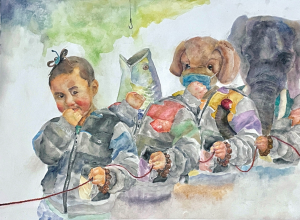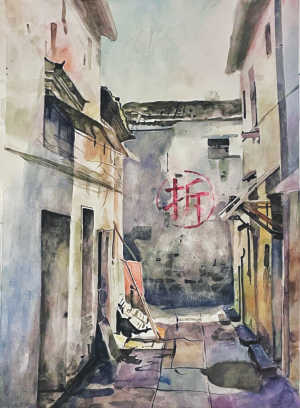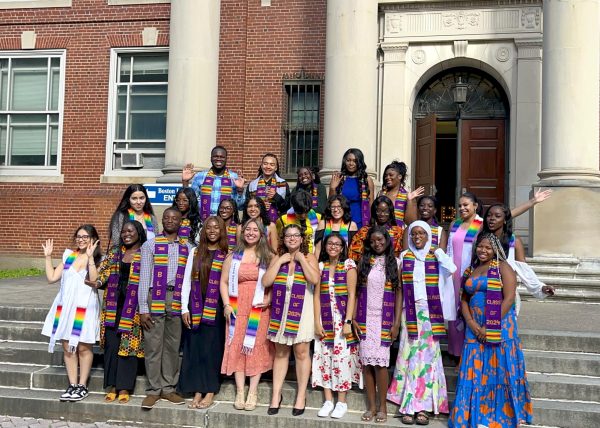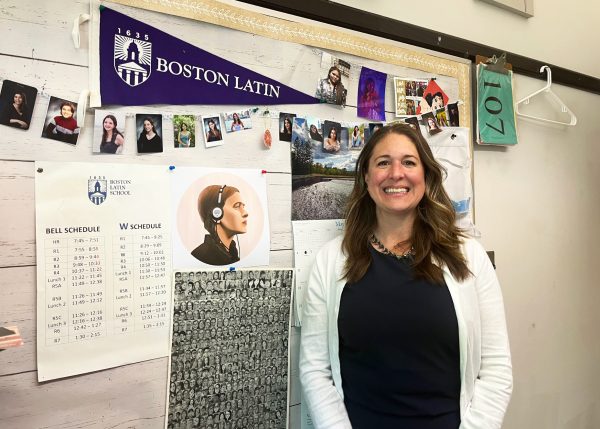Students Write Their Way to the Top
This year, 13 Boston Latin School students received awards for their creative works submitted to the national Scholastic Art and Writing Awards.
The Scholastic Art and Writing Awards competition is a nationwide program that recognizes young artists and writers in grades 7 through 12 for their creativity. Participants submit their art and writing works into 28 categories that include Architectural and Industrial Design, Printmaking and Critical Essays.
At a regional level, award recipients compete to earn gold keys, silver keys and honorable mentions for the creativity and craftsmanship of their work. According to the Scholastic Art and Writing Awards, luminaries look for pieces that “express an authentic perspective” and “blur boundaries.”
Award recipients who win gold or silver key awards may have their works advance to the national level, with the possibility of receiving gold or silver medals. The Scholastic Art and Writing Awards also offer participants the opportunity to win other recognitions for their pieces, including the American Visions Award and American Voices Award.
Winning these awards is no easy feat; each year the program has as many as 80,000 students across the country submit over 340,000 total entries.
Below are spotlights on four of the 13 BLS students who were recognized for their creative works:
Writing – Spotlight on Maya Koreth (III):
Maya Koreth (III) wrote a piece titled Salads, Spaceships, and Other Curious Beings, which won a gold key. Although it was framed as a humorous piece, Koreth wanted the piece to contain themes familiar with dystopian novels and also express the impact of global warming. Readers of her writing will immediately recognize traces of Douglas Adams and Neil Gaiman’s The Hitchhiker’s Guide to the Galaxy, which served as a source of inspiration for her during the writing process.
“It was a futuristic kind of human novel, where basically as a main character, [the protagonist] goes through a series of absurd events, until he realizes that the Earth is about to explode. […] It’s kind of like how he copes with that understanding, and also how it ties into like other events that are happening in the world,” Koreth explains.
Koreth’s idea for the story originated during the summer, but her piece went through many revisions with suggestions made by friends and teachers. Koreth also garnered help from an online tool, known as paper.co.
Koreth incorporated techniques such as alliteration and symbolism into her writing. The main character in the piece encounters various unusual events and alien creatures unfamiliar to Earth, which helps bring a humorous side to the overall story.
Writing – Spotlight on Angelina Tang (IV):
Angelina Tang (IV) submitted two pieces: a short story titled For the Swan Wishes to Dance and a fantasy piece titled The Gardener’s Flower, which received a silver key and honorable mention.
For the Swan Wishes to Dance follows two girls in the setting of a ballet academy, inspired by Tang’s real life experiences. Eloise, the Black Swan, is the valedictorian of the academy, and Annetta is the white swan, second-in-command.
Tang explains, “I wanted to address the topic of jealousy. And I thought it would be interesting if the main character wasn’t necessarily the heroine.”
The Gardener’s Flower, on the other hand, featured the mystical world of a witch, a Demon King called Magoth, and an immortal girl. These characters were initially inspired by the video game Genshin Impact.
Art – Spotlight on Hannah Yu (III):
Afternoon Tea was an oil painting depicting a teapot. Hannah Yu (IV) originally started occasional art classes, and rediscovered her hobby of art two years ago.
“Throughout my whole life, I always loved drawing. I was known for that, especially in elementary school. I was associated with my art all the time. […] Reflecting back on that, I realized I actually think this is [something] I have a talent in, and I think this is something I enjoy,” says Yu.
While working on this piece, Yu gained experience in different techniques, especially in expressing shadows, and creating depth in terms of light and dark. Reflecting back on what she learned from the process, Yu explains, “My art teacher always told me to put your own personality into the photo [and] your own interpretation.”
Every Sunday afternoon, she painted for three hours, and eventually, after multiple revisions, she settled on titling her painting Afternoon Tea.
Art – Spotlight on Yuxuan(Lucy) Zhang (IV):
This year, Yuxuan (Lucy) Zhang (IV) earned a silver key for her painting Boundless Identities and an honorable mention for her painting In the Passage of Time.
“I found art is a perfect way to capture the moments of life. […] And it is always really really satisfying to see the final thing come out,” says Zhang.
According to Zhang, it takes her around one and a half months to complete a piece. Her piece Boundless Identities depicts a young child holding a string connected with a fish, dog, and elephant.
“I thought about how [the character] imagined themselves having friends that are imaginary when [they are] little. So I drew three other animals, representing different identities. […] All of them are really different from each other, but yet they’re connected through the string they’re holding on the hand,” says Zhang.
Her second piece, In the Passage of Time, drew inspiration from traditional Chinese architecture, known as hu tong, commonly found in Beijing.
She explains, “With the fast advancements of the society, a lot of these hu tong and original architectures are being torn down. So the character in the middle in red represents that this building is about to be torn down, and it also represents how different people have lived in this place. But right now, it is being demolished and represents a fresh start for the new era, but also commemorates the past.”
Her favorite art media are colored pencils and watercolor, both of which were utilized in the pieces she submitted this and last year. The piece Boundless Identities employed unique watercolor techniques, using splattered salt onto the paper and letting the pigments bleed through the water.









